

After visiting San Marino, Alizia and Roberto brought us to nearby San Leo which lies a bit west and south of San Marino. A settlement has existed here since pre-Roman times, and was eventually called Montefeltro. According to a history written in the year 900, Saint Leo and Saint Marino came to Italy around the year 600 to escape persecution back in Croatia. Saint Marino established San Marino, and Saint Leone settled in Montefeltro.
In the year 1000 the village was renamed to San Leo in his honor.After finding a parking spot, we walked into the old city center and one of the first things we saw was the Parish Church of Santa Maria Assunta. This church was built in 882, although some elements within it are reused from even older buildings. It was partially rebuilt a couple of hundred years after that. This is definitely one of the oldest buildings we have been in.
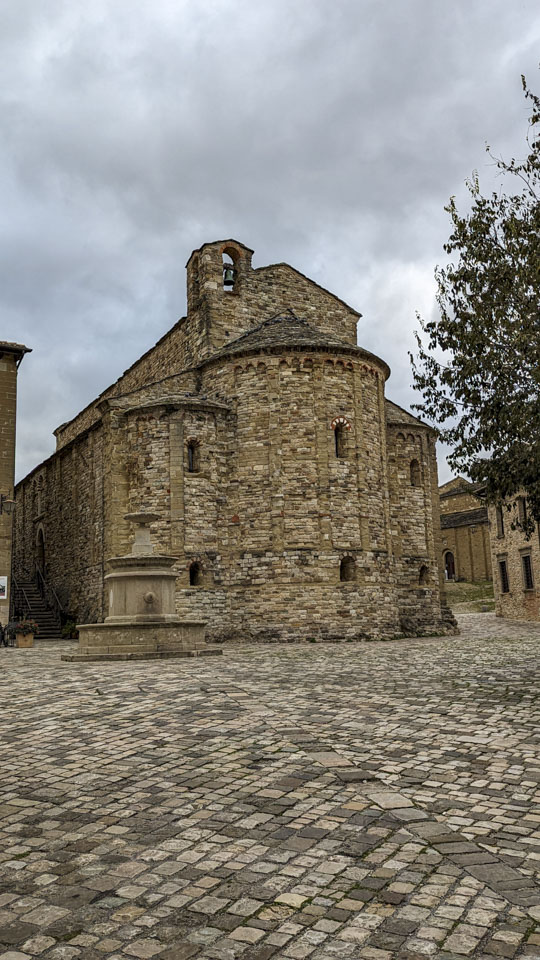
There was one long row of pews down the center of the church.
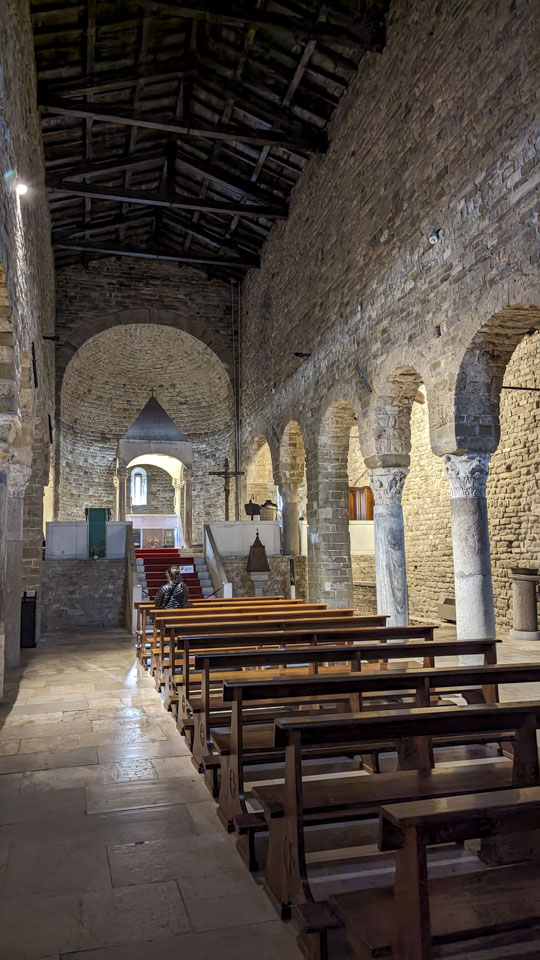
The church had a small traditional looking organ in the back.
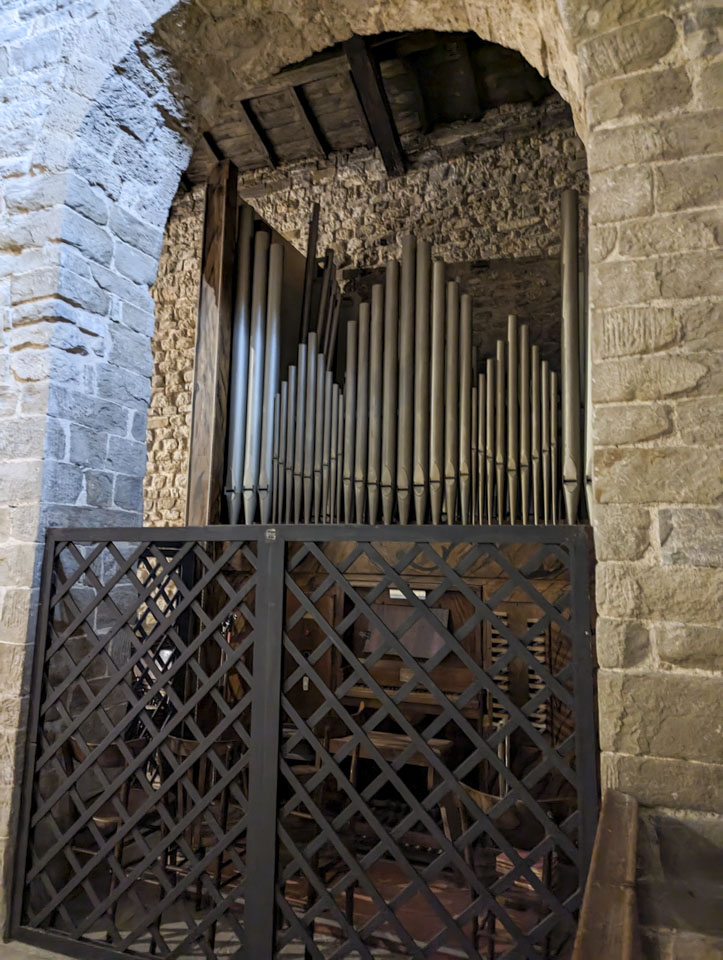
Across a stone and grass yard is another church, Cathedral of San Leo. Although it was built around 1200, it is at the site of an even earlier church that dates from the 600s and the arrival of San Leo. Parts of the earlier church are incorporated into the current church. The Cathedral complex includes this cathedral and the Parish Church of Santa Maria Assunta (pictured above), and once had a few other buildings.
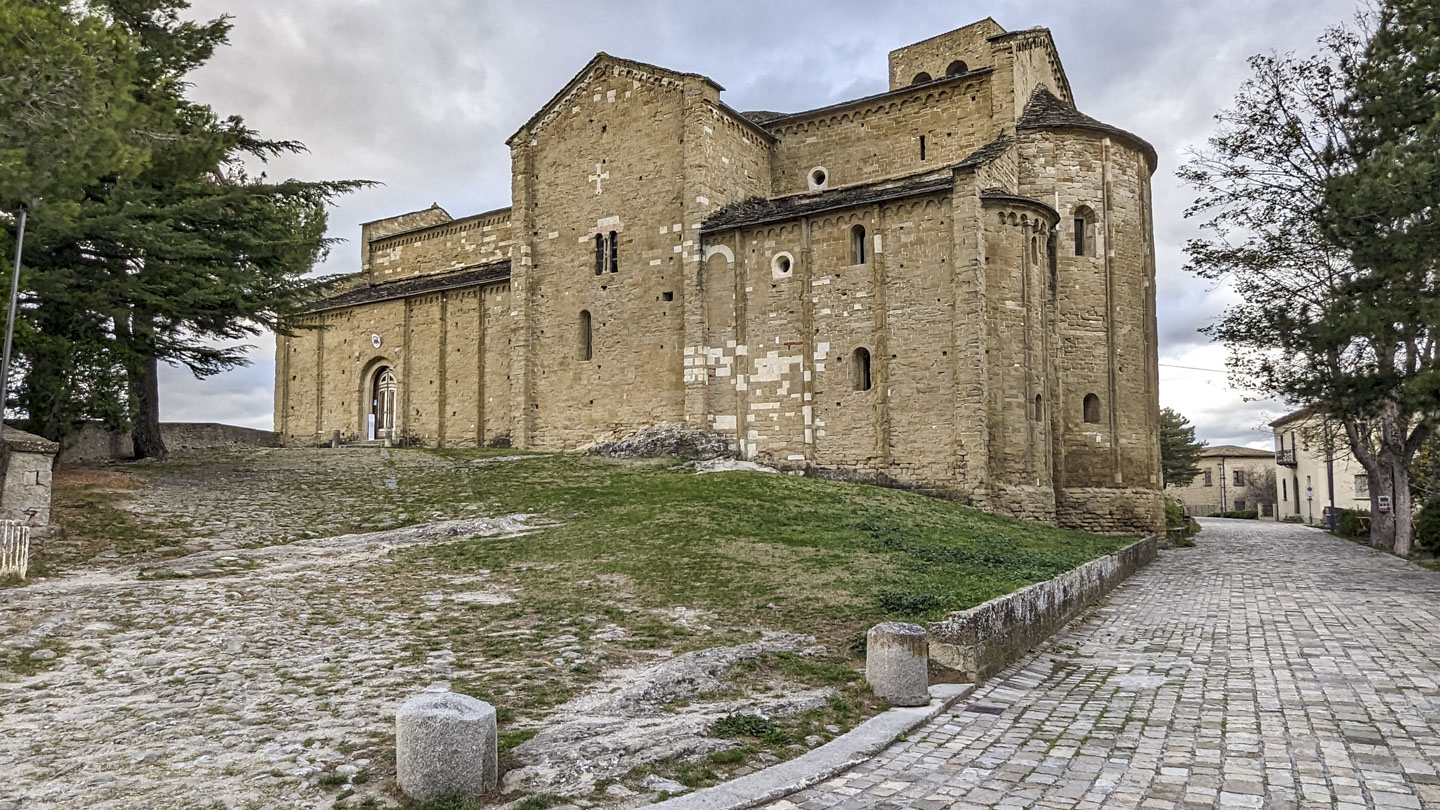

The cathedral, as indeed most buildings in San Leo, does not have a foundation but instead is built directly on the rock. They celebrate this by making the bedrock obvious within the architectural design.
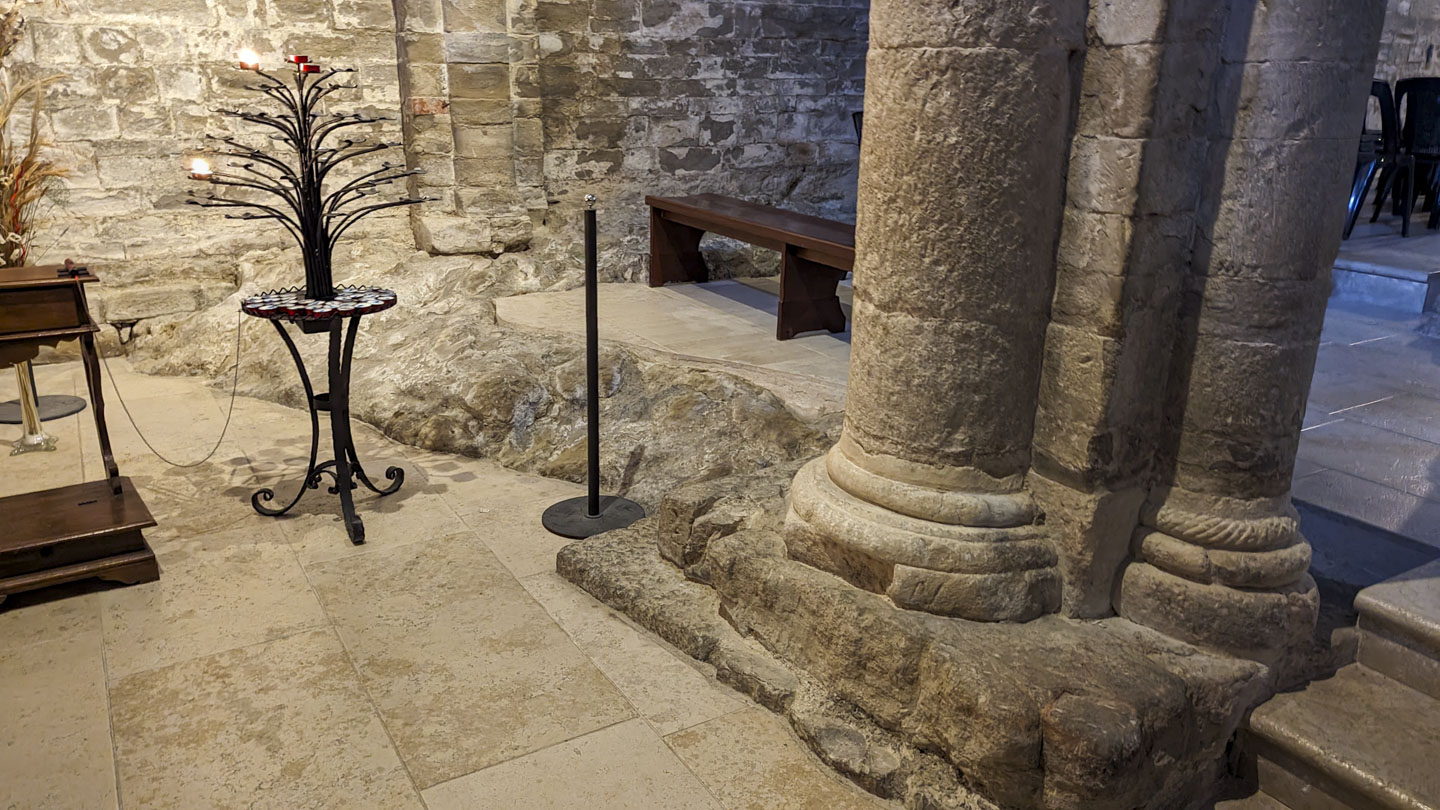
Looking back from the upper level of the church gives a good perspective, and also shows an organ from 1964 at the back of the church. While many places in Italy like to juxtapose modern and ancient, we are not confident that this particular design goes well with this church's decor.
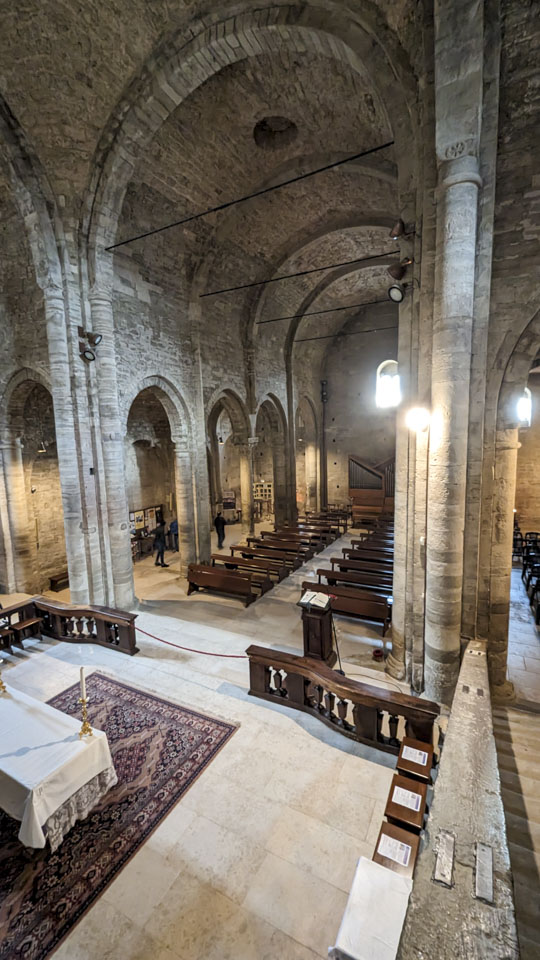
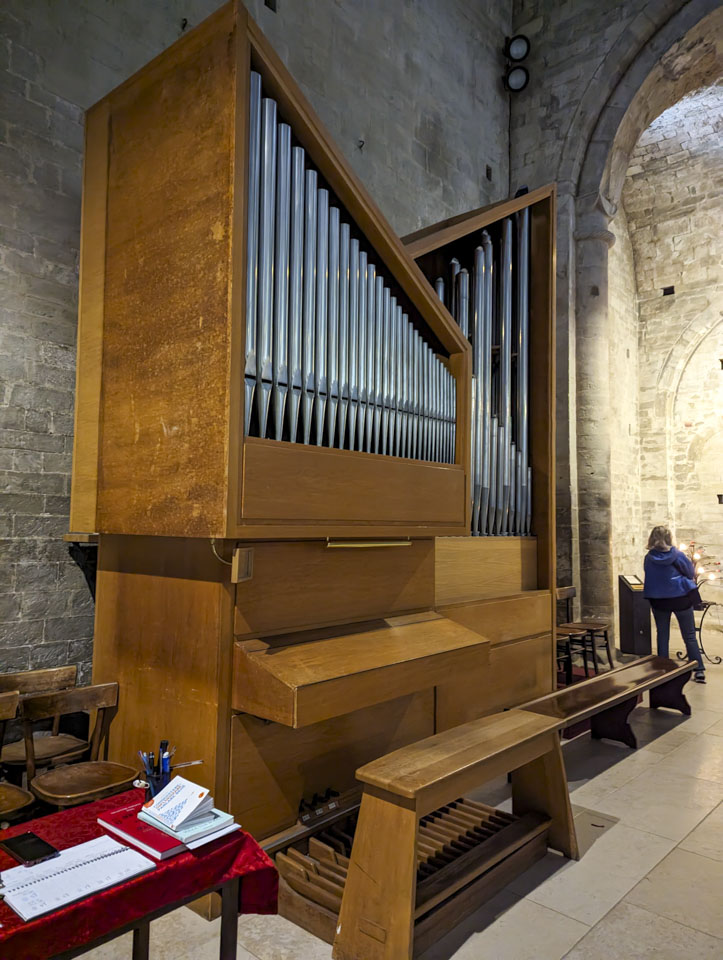
The church has a lower crypt level. The large signs in this area are simply diagrams of the church.

Interestingly, only the lid of Saint Leo's tomb is here. The saint's remains actually reside in another community (Voghenza, about 2.5 hours away).

When we stood between the two churches, looking east showed the Fortress of San Leo standing imposingly on the cliff above the village.
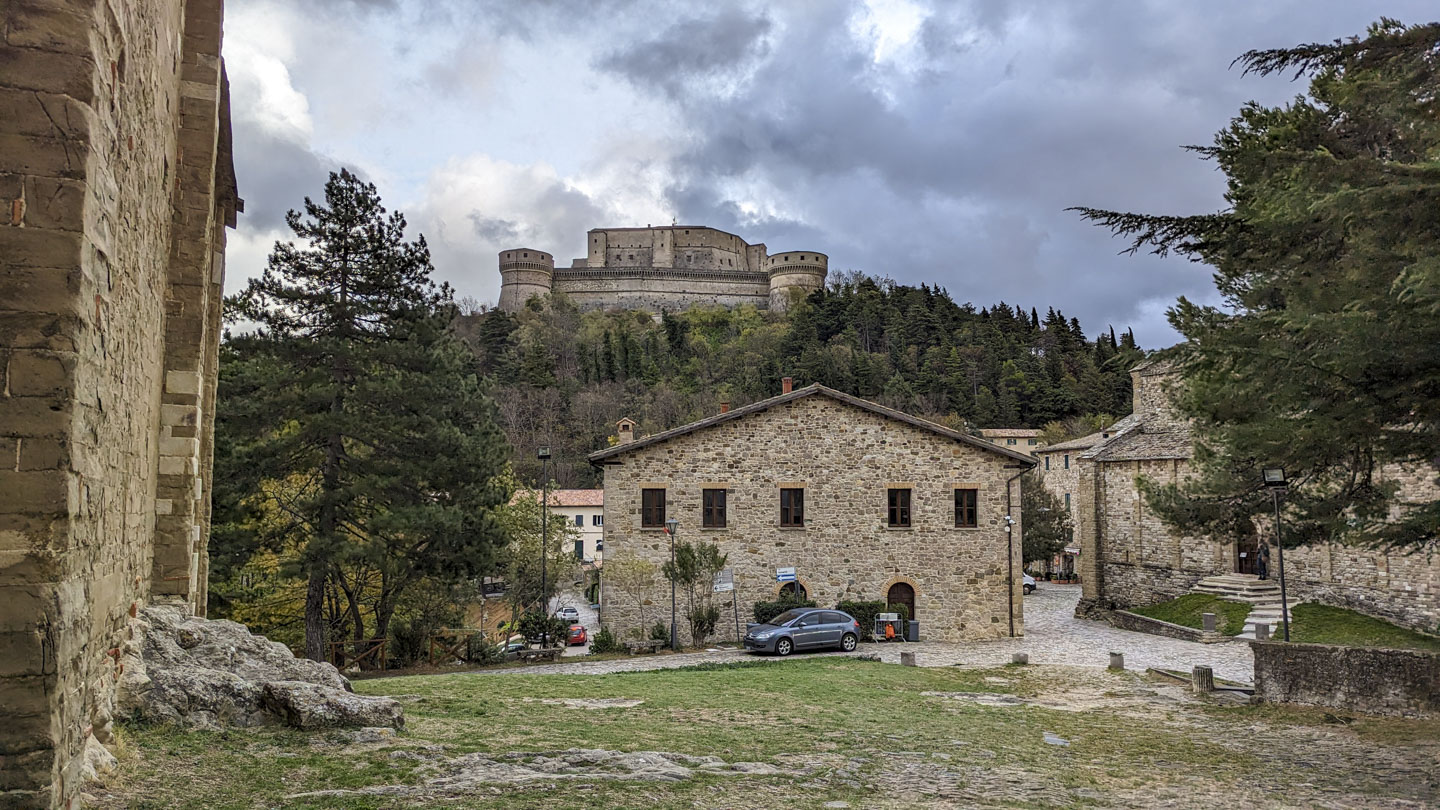
Looking towards the west shows a more mountainous landscape.

Above, we mentioned that San Leo was once known as Montefeltro (which would translate to 'felt mountain'). An informative sign in the village explained that after the name was changed, a prominent family adopted the name. This family became one of the two most prominent dynasties in the area, the other being the Malatesta family of Rimini. In the 1400s Federico Montefeltro defeated the Malatesta and became the Duke of Urbino. We have seen many villages with forts created with funding from either the Montefeltro family or the Malatesta family. The Fortress of San Leo was modified to its current appearance by Federico. In honor of the 600th anniversary of Federico's birth this mural was painted on a wall next to the piazza that bears his name.
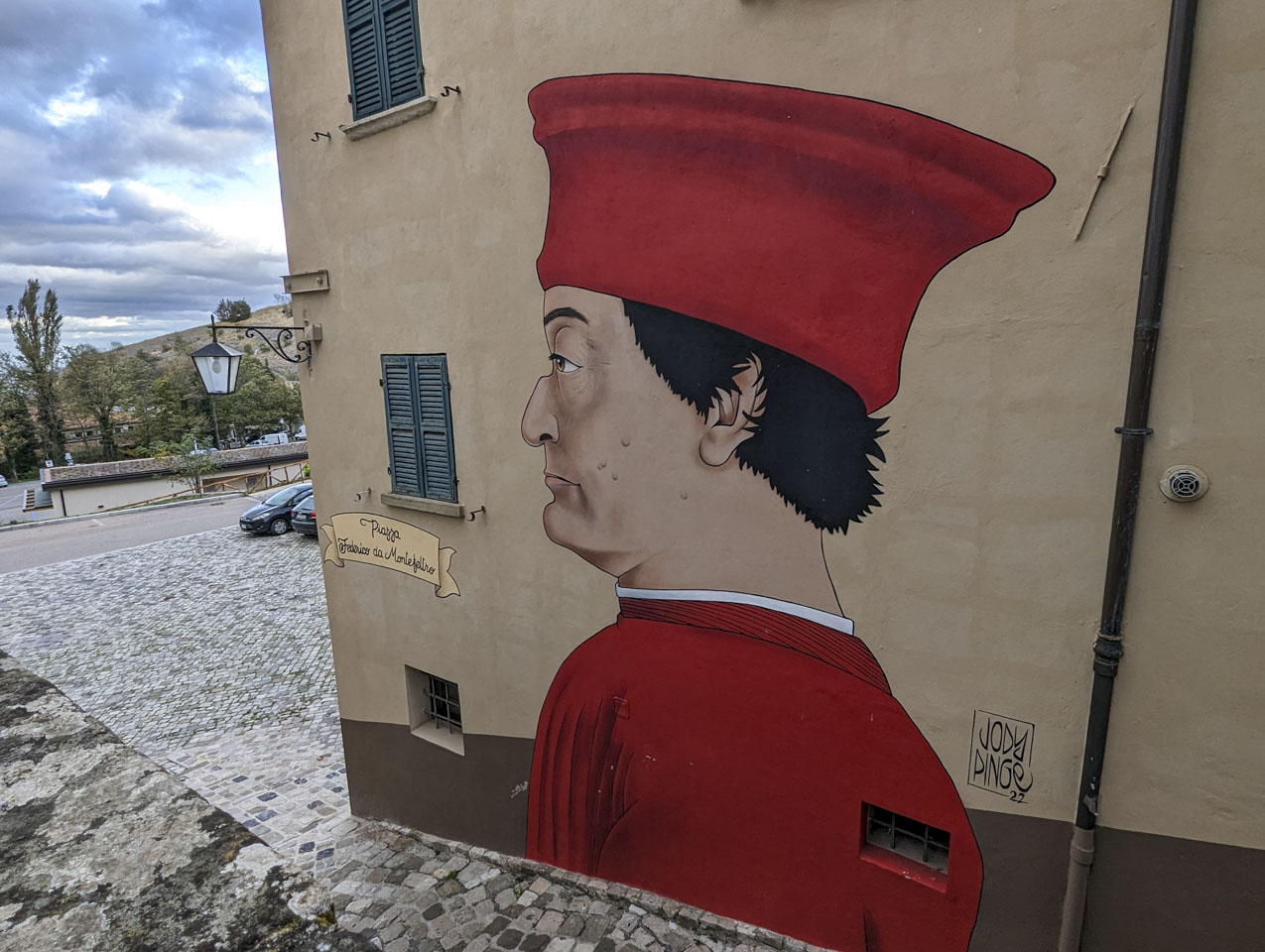
To get to the fortress, we had to walk up the hill. Fortunately, they had a nice path. When we got to the top we felt that the fort was as imposing up close as it was from below.
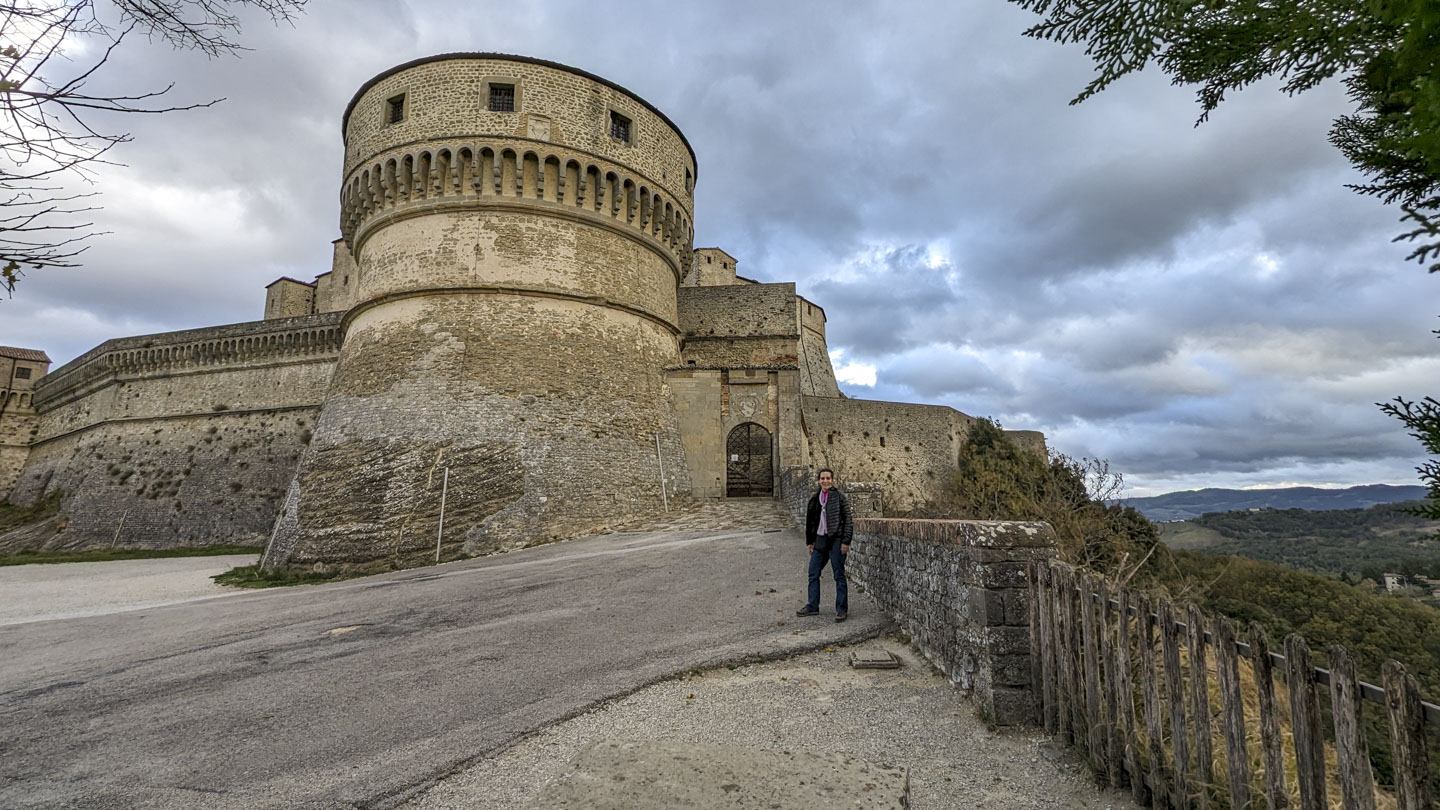
The fort has walls within walls. After we went through the entrance, we found ourselves in an outer courtyard. We could go through the small door on the left to be within the wall, or through the archway on the right to go to the inner courtyard.
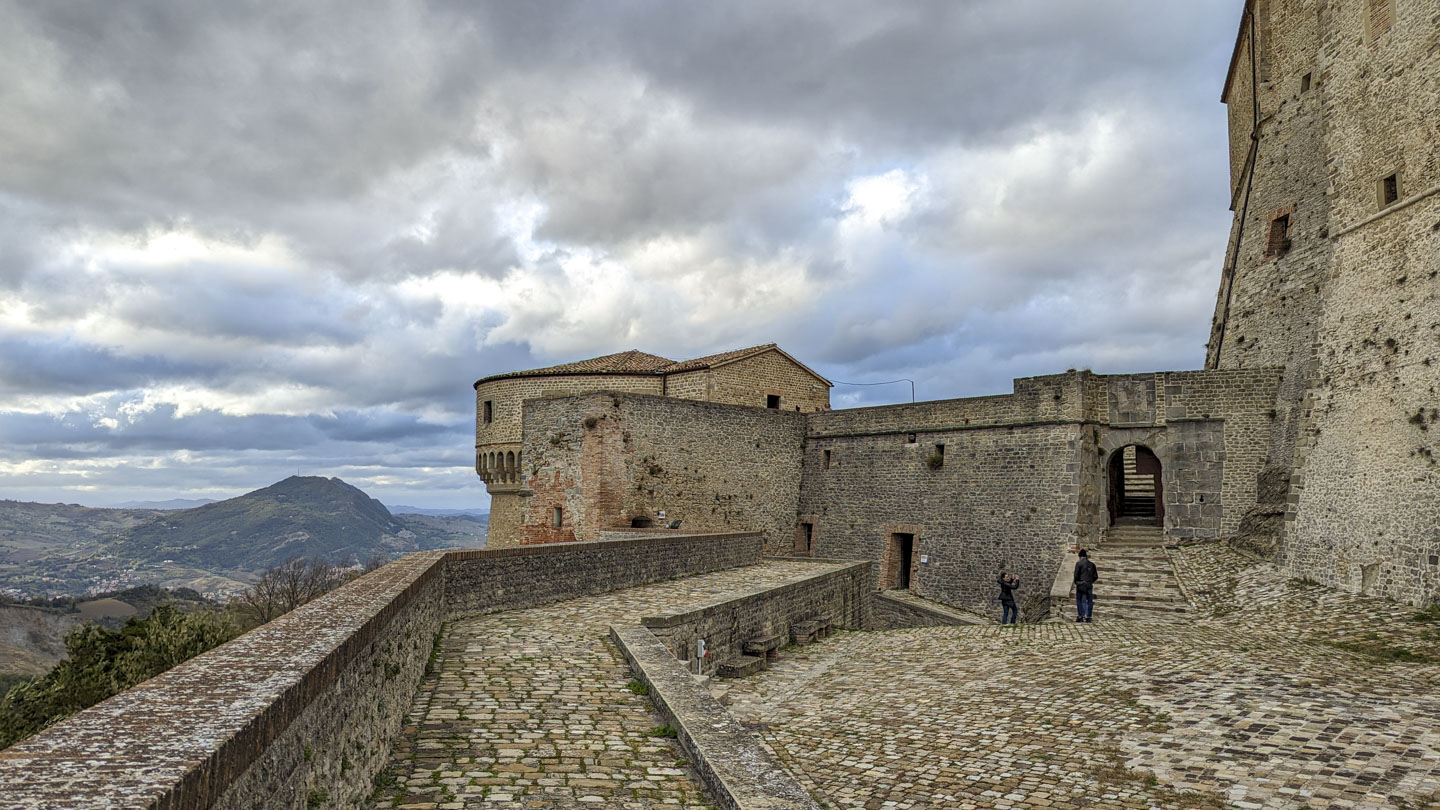
We opted for the door on the left. This led us to some embrasures (spots with loopholes, aka shooting holes) at various levels.
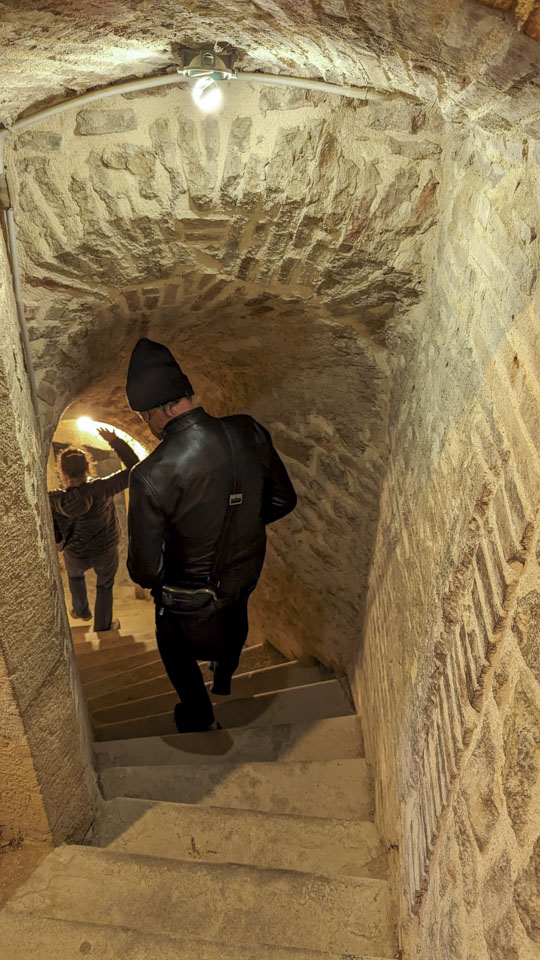

The views are suitably impressive from the fort. The village can be seen far below. The tower is known as The Roman Tower. To the left of the tower is the Cathedral of San Leo, and moving left again you see the Parish Church of Santa Maria Assunta. Going back to the tower and looking right, you can see a park with a monument at the end; that is the monument to those who have died in wars.
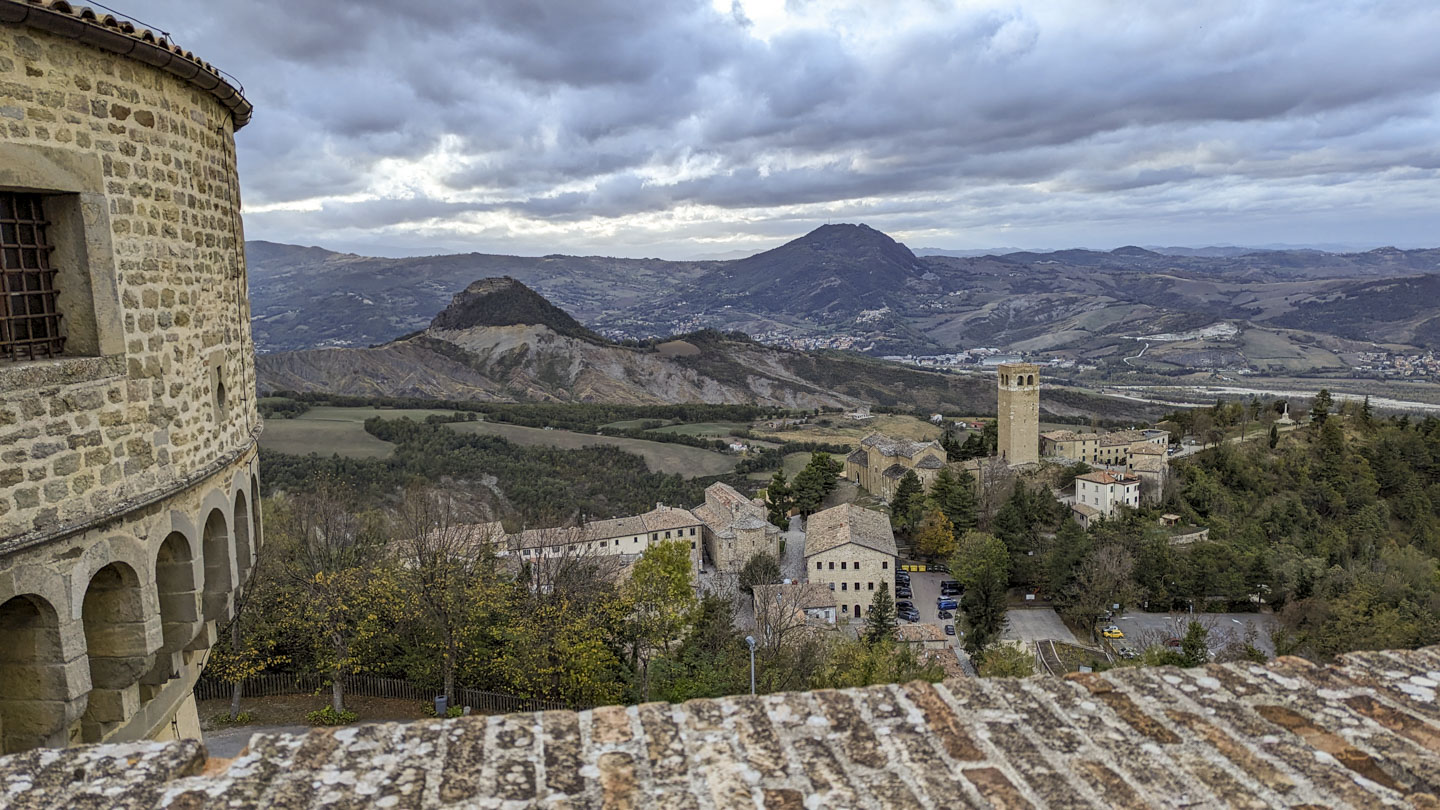
Looking East, the village of San Marino is visible. (The picture at the beginning of the San Marino page was actually taken from San Leo.)
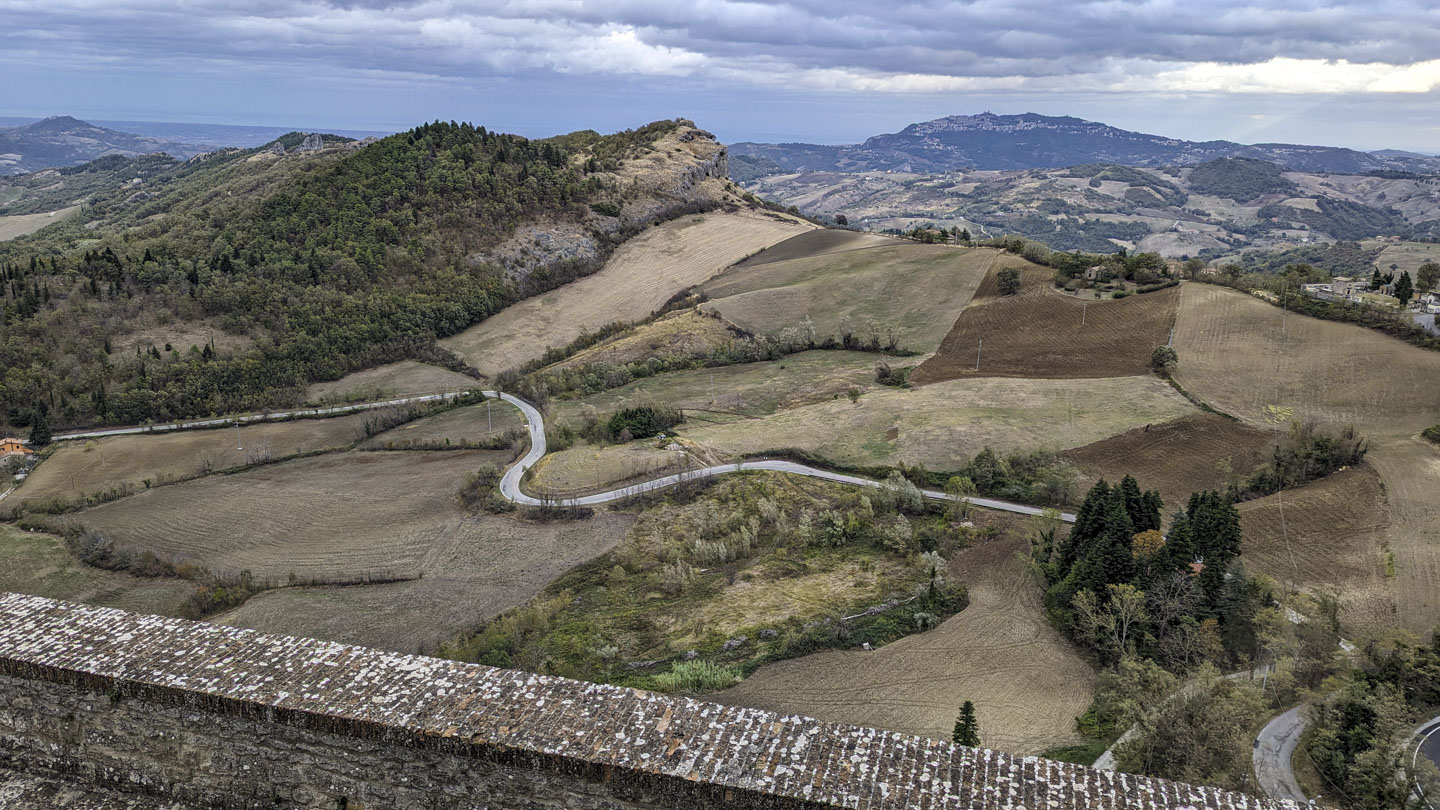
The towers have rooms at their tops, with some displays along the walls. These rooms are also available to host meetings, based on the number of chairs we saw.

As we showed in the Cathedral below, the bedrock is part of the building.
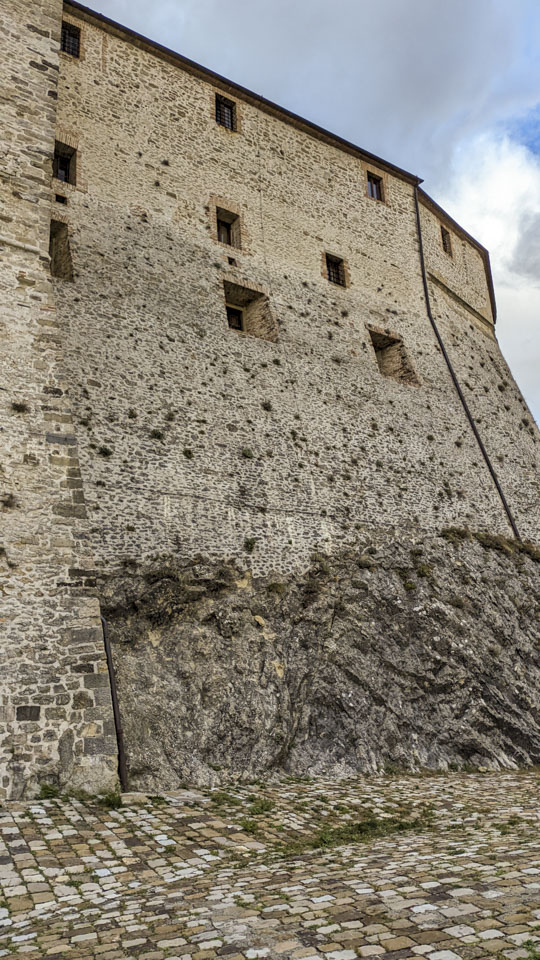
Admission to the fort included a very interesting 'interactive museum' display, which they call MusLeo. A famous Italian actor narrates the story while corresponding shadow images are shown on the walls. Fortunately, the images also included text in English and German. We do not know why, but a black cat is the symbol of the interactive museum and was used in many of the shadow images.
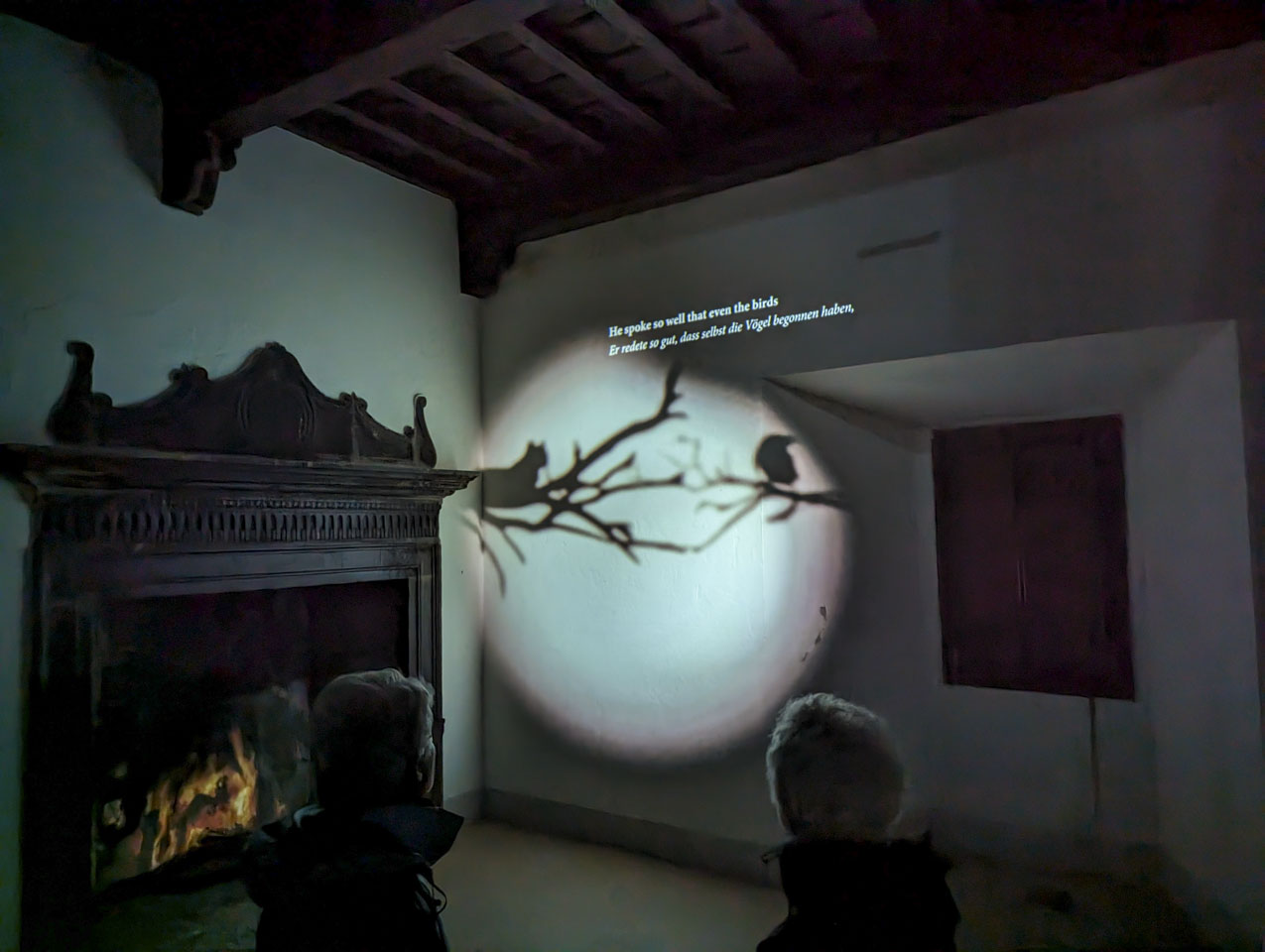
The story told us about Dante, who stayed at the fort and used it as the imagery for purgatory. It told us about Saint Francis, who visited and preached here. The saint impressed one of the local nobles so much that the nobleman donated land to the saint, where eventually the Sanctuary of La Verna was established. And the story told us about Alessandro Cagliostro. Cagliostro was actually Giuseppe Balsamo, a poor but educated con man who convinced many people that he was actually a nobleman and physician. It is said that he put some of his swindled funds to good use for the aid of children, since he was orphaned at a young age. He was eventually convicted for various crimes and imprisoned in the fortress. Since Cagliostro was a magician, among other things, it was feared that he would be able to escape. He was put in a room with no door, only a hole in the ceiling. This small room had one window, covered with bars, that provided a very limited view of the outdoors. He arrived at the fortress in 1791 and died in 1795. A doorway entrance has since been made in the room, so we were able to go into it.


The fortress also had a torture area (which, as far as we know, Cagliostro was not subjected to). Roberto demonstrates the board where a prisoner might have his hands tied up, and Alizia shows how the heavy stone could keep a person from walking very far.
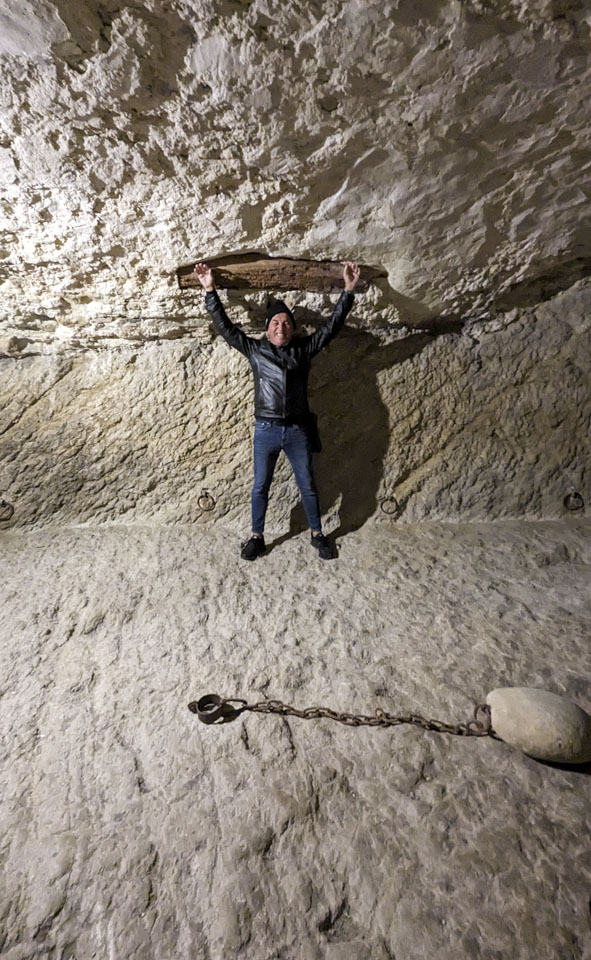
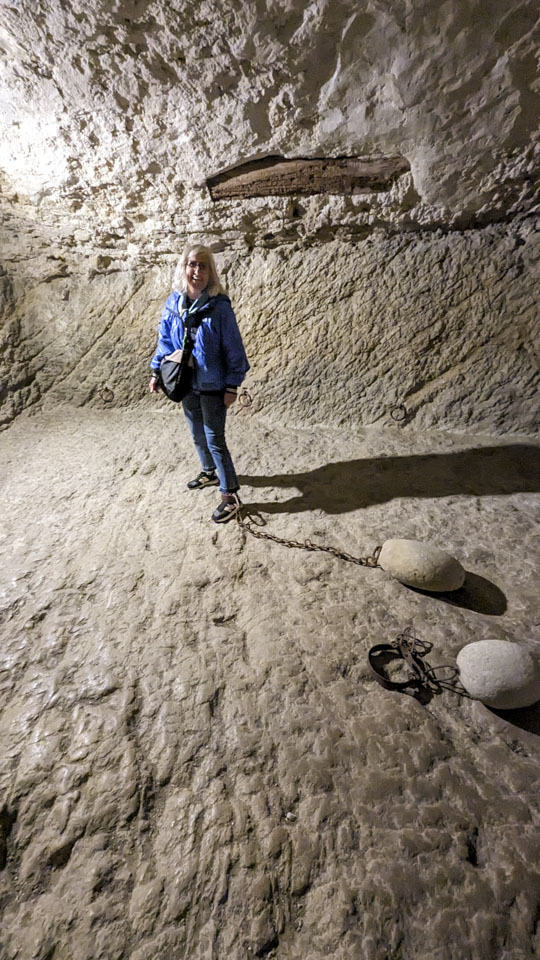
Here is another view of the fort, taken from one of the courtyards. A bit right of center is a slanted wall that is actually a staircase. The subsequent photo shows Anne, Alizia, and Roberto stnading near those stairs; you can see that it is a very high wall.

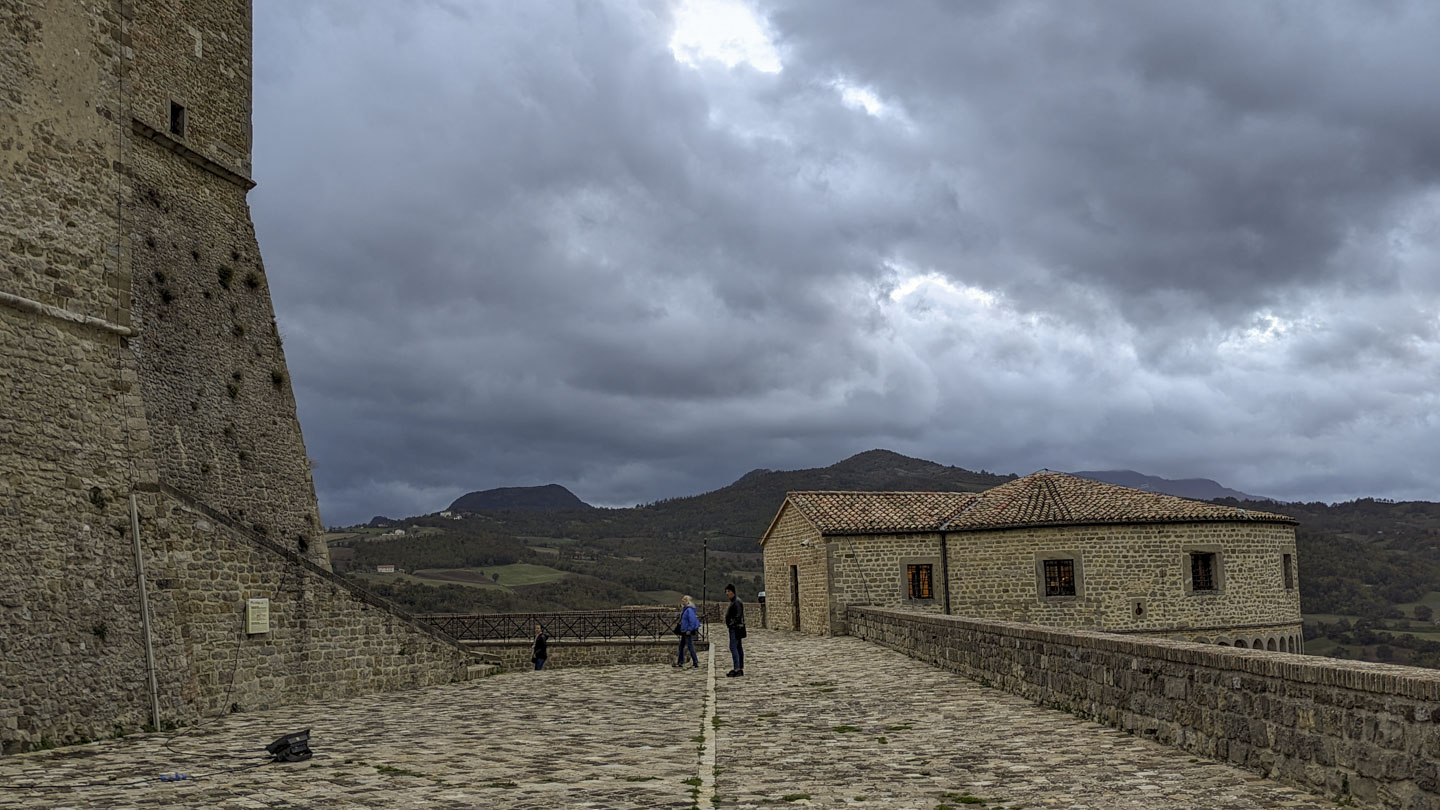
Before leaving Paul took this video.
After our tour of the fortress, we walked back down to the village of San Leo. The day was fading and lights were starting to come on. Here we look past the Parish Church of Santa Maria Assunta back up towards the fortress.
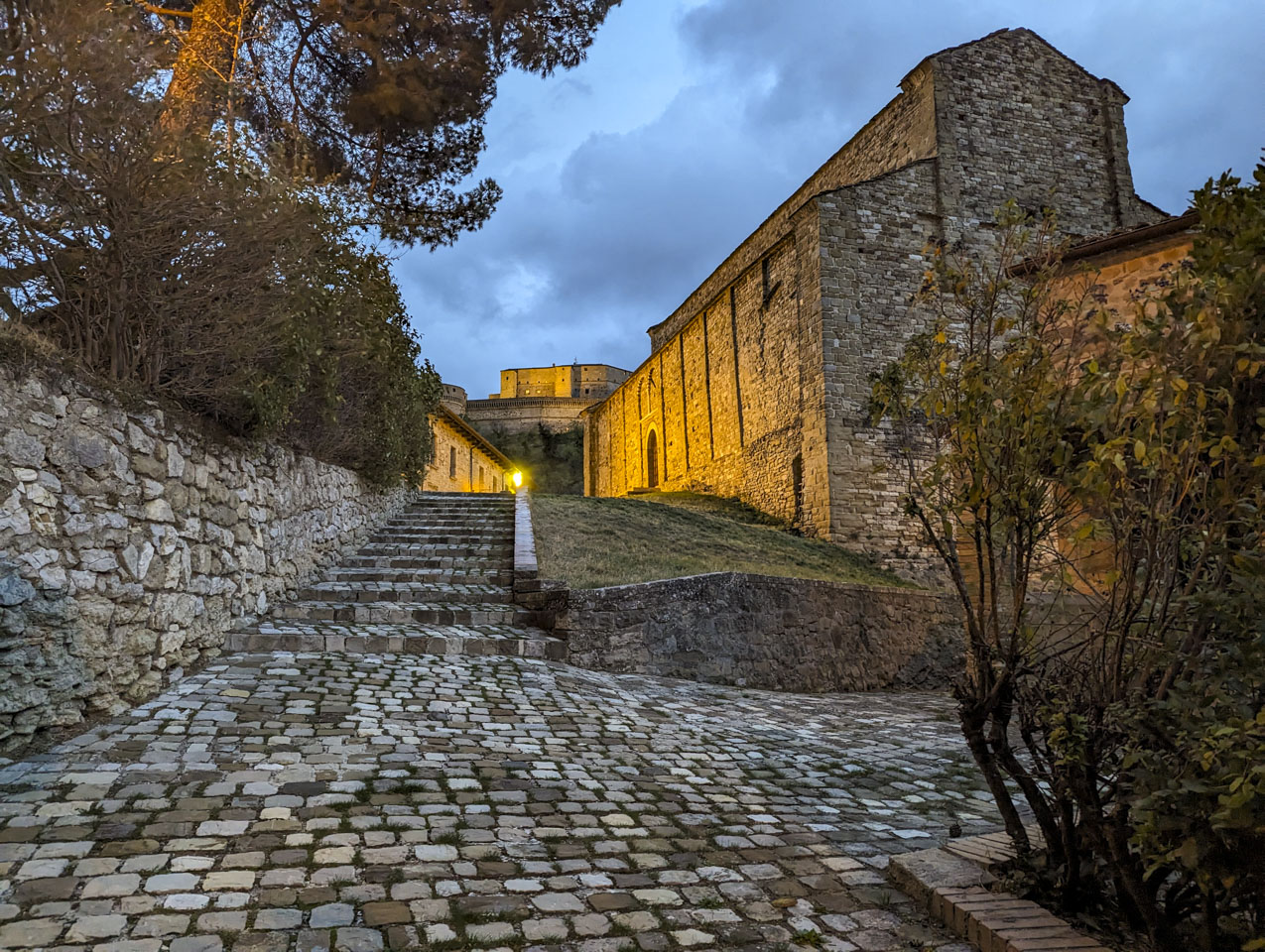
As we saw from the elevated height of the fortress, near the churches sits the Roman Tower. Continuing down the path leads to the park and monument that we saw from the fortress. This provided a nice view back at the tower and fortress, but it was very windy.


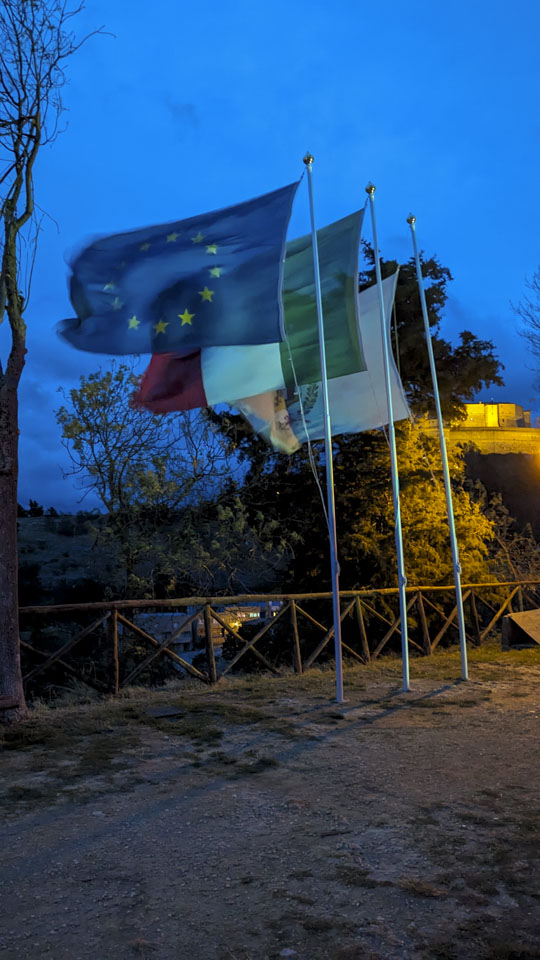
Here is a video that Paul took that can give you an idea how windy it was.
We paused to take a picture from the road on our way out, to capture what the sheer cliff wall side of the fortress looks like. There was not much worry of attack from this side.

After hosting us for a fabulous day of touring, Alizia and Roberto were kind enough to invite us up to their apartment in Pesaro. They have an amazing view, even at night, out to the nearby natural park and the sea.
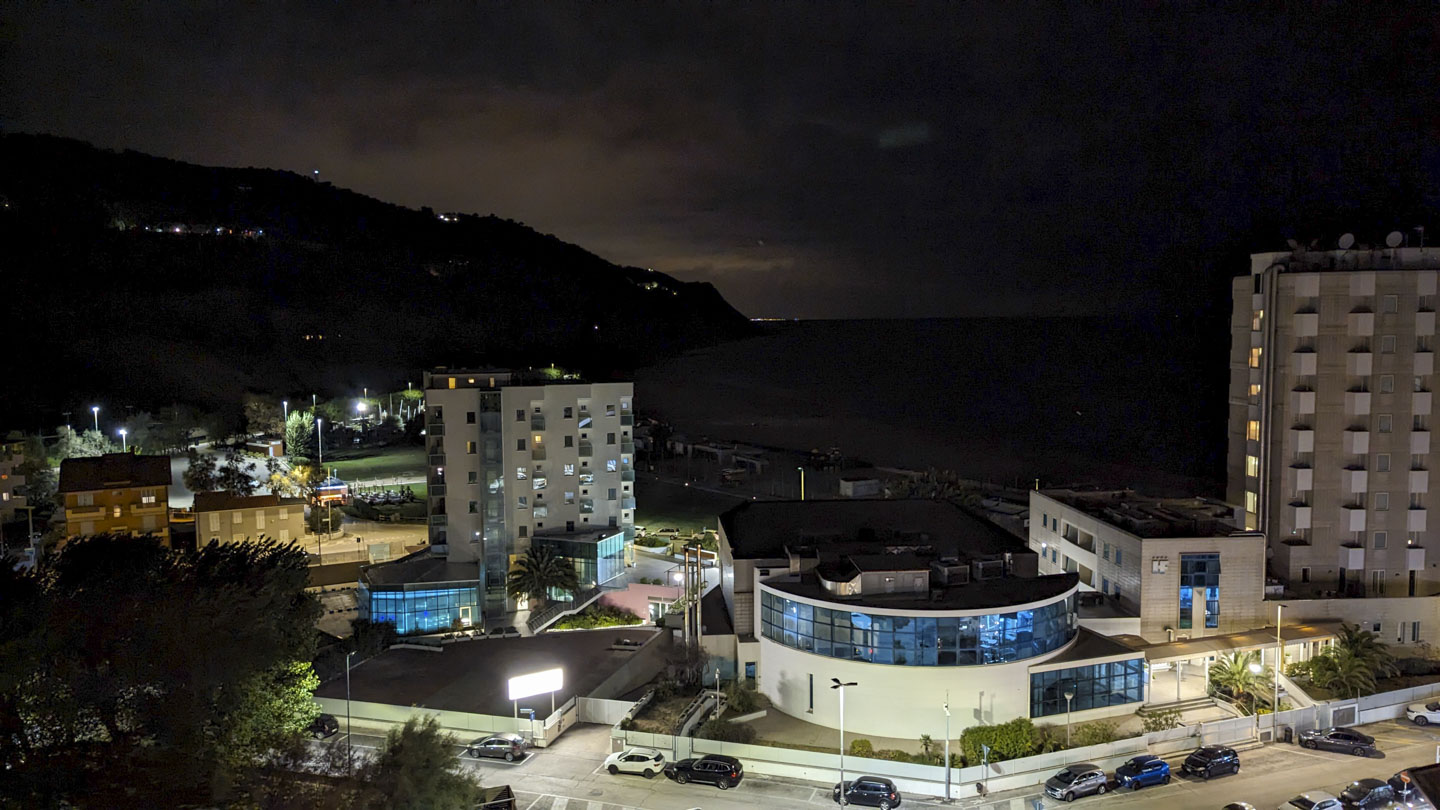
Our 'light' dinner was a variety of greens, green beans and potato, a pomegrante fennel salad, fresh piadini (the local flat bread; Paul and Roberto walked over to the shop to get it immediately before dinner), and various cheeses. We were also able to try Lacrima di Morro d'Alba wine. The lacrima grape is a local grape that is rarely found outside of Morro d'Alba, which of course means that the wine is not easy to find. We are surprised that it has not spread because it went very well with the meal.
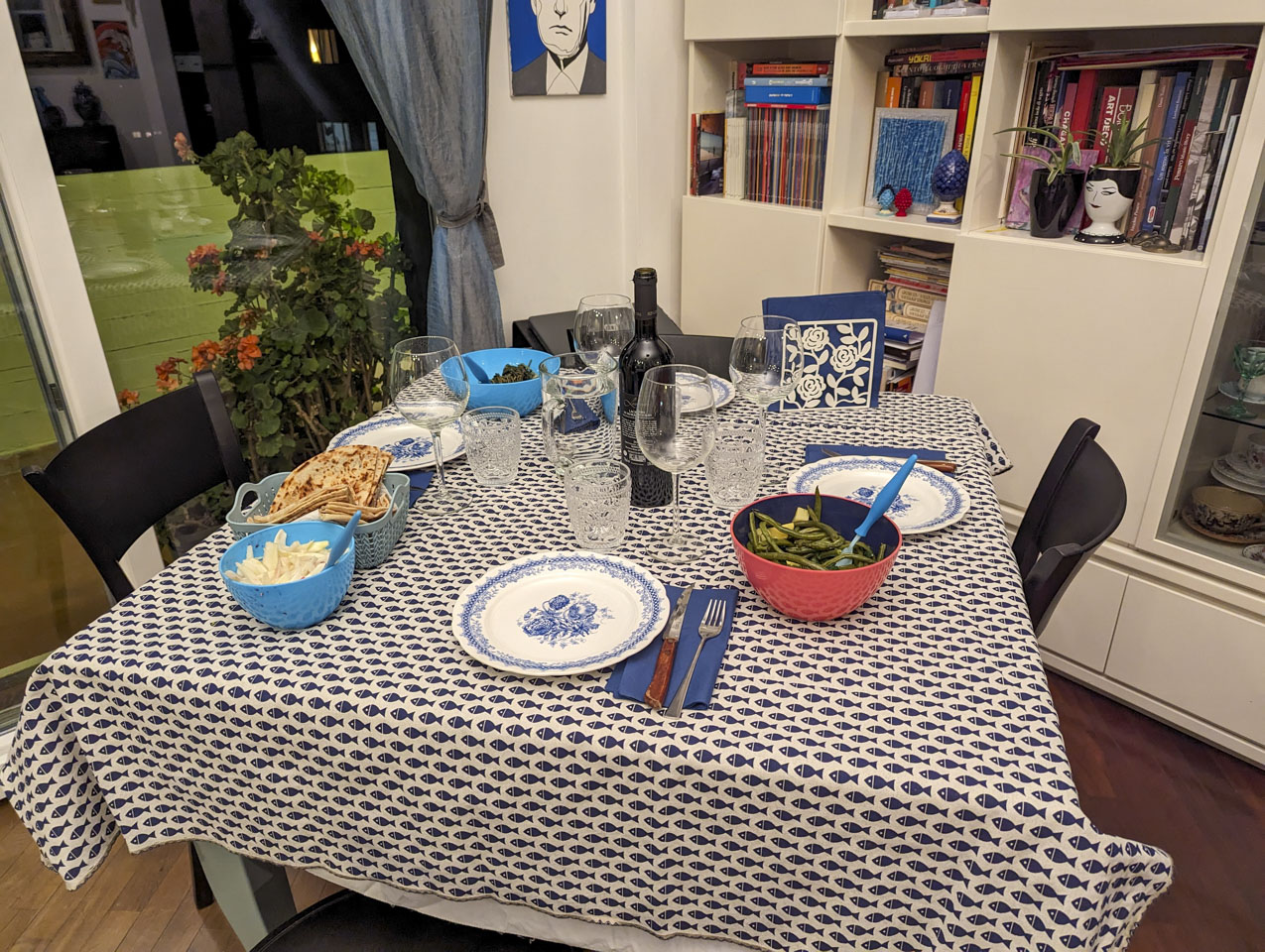
We ate well.
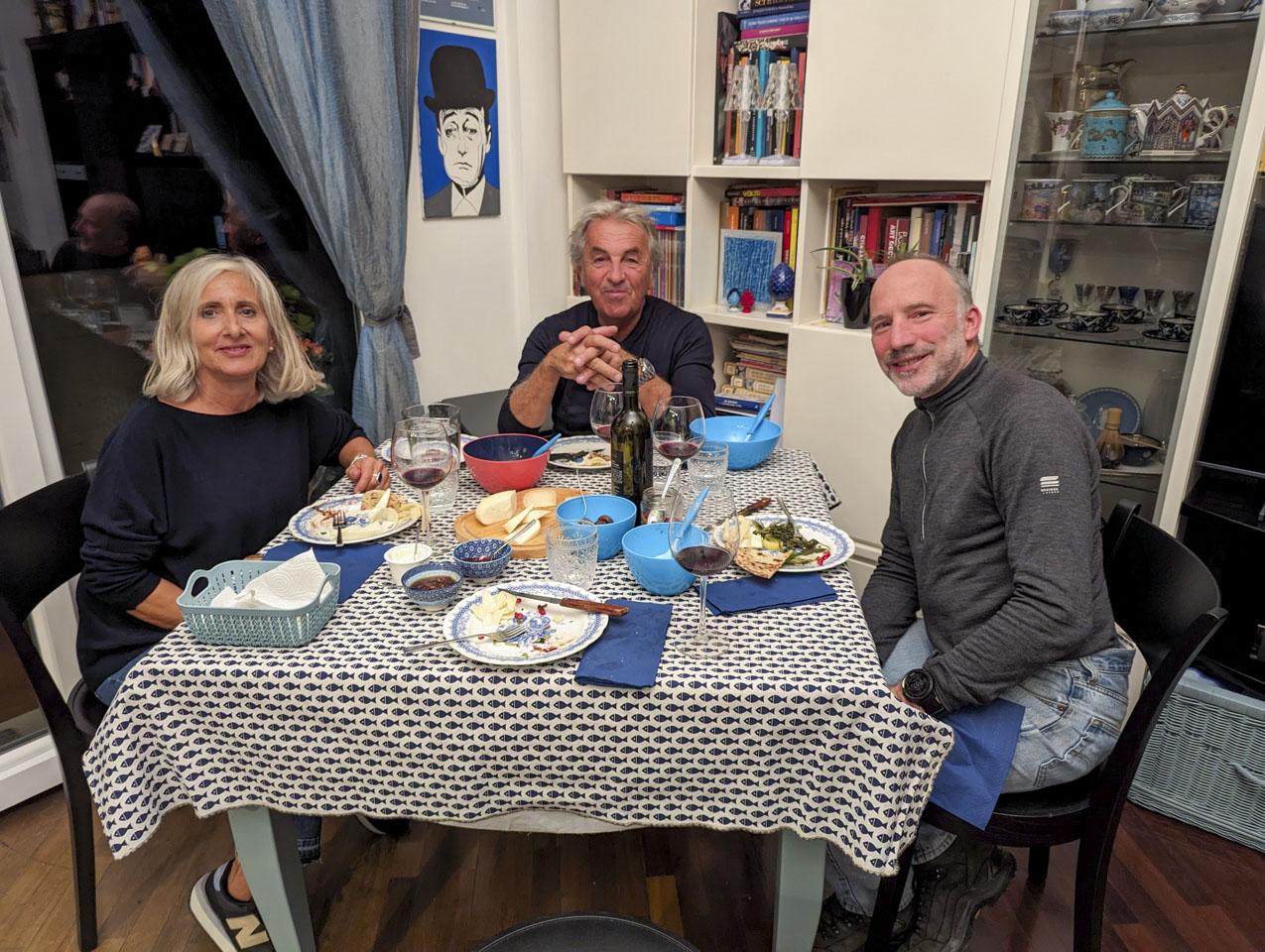
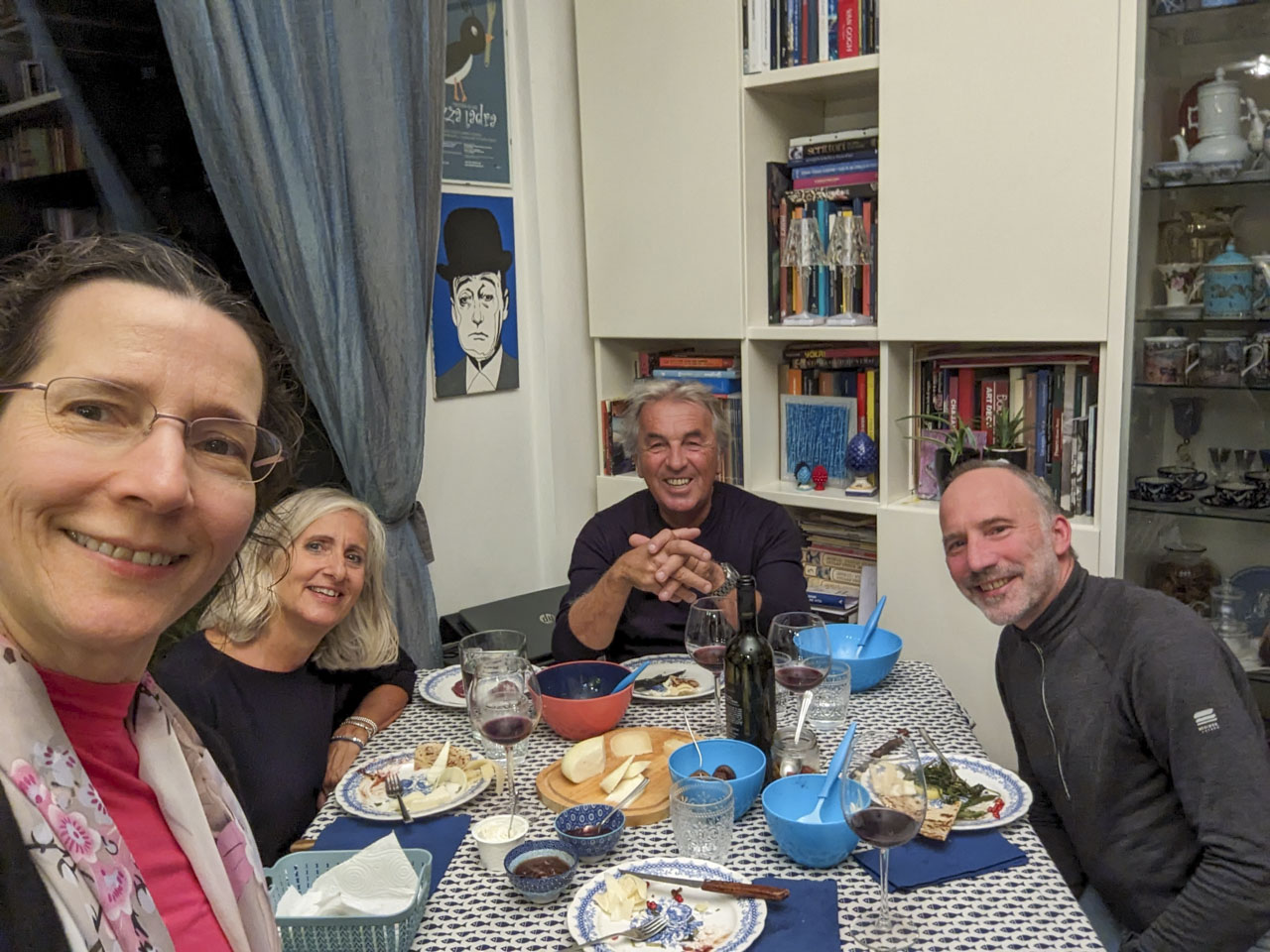
This was a full and fabulous day.
Updated November 2024